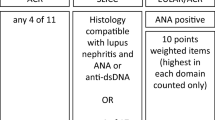Abstract
Leukotriene B4 (LTB4) was measured in synovial fluid from 20 patients with rheumatoid arthritis and 15 patients with osteoarthritis. The level of LTB4 was significantly higher in synovial fluid from rheumatoid arthritis patients as compared with synovial fluid from osteoarthritis patients. LTB4 levels also significantly correlated with cell numbers, rheumatoid factor, and immune complexes in synovial fluid from rheumatoid arthritis patients. There was an inverse correlation between LTB4 levels and complement components. The high-pressure liquid chromatography peak of immunoreactivity extracted from the synovial fluid occurred at a retention volume identical to that of authentic LTB4. These results suggest that the increased level of this mediator in synovial fluid may contribute to perpetuation of inflammation and tissue destruction in rheumatoid arthritis.
Similar content being viewed by others
References
Henderson, B., andE. R. Pttipher. 1985. The synovial lining cell: Biology and pathobiology.Semin. Arthritis Rheum. 15:1–31.
Bray, M. A., A. W. Ford-Hutchinson, andM. J. H. Smith. 1981. Leukotriene B4 an inflammatory mediator in vivo.Prostaglandins 22:213–222.
Ford-Hutchinson, A. W., M. A. Bary, M. V. Doig, M. E. Shipley, andM. J. H. Smith. 1980. Leukotriene B4, a potent chemokinetic and aggregating substance released from polymorphonuclear leukocytes.Nature 286:264–265.
Davidson, E. M., S. A. Rae, andM. J. H. Smith. 1983. Leukotriene B4, a mediator of inflammation present in synovial fluid in rheumatoid arthritis.Ann. Rheum. Dis. 42:677–679.
Rae, S. A., andM. J. H. Smith. 1981. The stimulation of lysosomal enzyme secretion from human polymorphonuclear leukocytes by leukotriene B4.J. Pharm. Pharmacol.33:616–617.
Valerie, E. J. 1989. Rheumatoid arthritis; rheumatoid factors, immune complexes, and Creactive protein are raised shortly after the onset of symptoms.Arthritis Rheum. 32:117–119.
Simmons, P. M., J. A. Salmon, andS. Moncada. 1983. The release of leukotriene B4 during experimental inflammation.Biochem. Pharmacol. 32:1353–1359.
Ropes, N. W., G. A. Bennett, andS. Gobb. 1958. Revision of diagnostic criteria for rheumatoid arthritis.Bull. Rheum. Dis. 9:175–176.
Klickstein, L. B., C. Shapleigh, andE. J. Goetzl. 1980. Lipoxygenation of arachidonic acid as a source of polymorphonuclear leukocyte chemotactic factors in synovial fluid and tissue in rheumatoid arthritis and spondyloarthritis.J. Clin. Invest. 66:1166–1170.
Hay, F. C., L. J. Nineham, andI. M. Roitt. 1976. Routine assay for the detection of immune complexes of known immunoglobulin class using solid phase C1q.Clin. Exp. Immunol. 24:396–400.
Kent, J. F., andE. H. Fife. 1963. Precise standardization of reagents for complement fixation.Am. J. Med. 12:103–116.
Platts-Mills, T. A. E., andK. Ishizuka. 1974. Activation of the alternative pathway of human complement by rabbit cells.J. Immunol. 113:348–358.
Lansbury, J. 1979. Method for evaluating rheumatoid arthritis.In Arthritis and Allied Conditions, 9th ed. J. L. Hollander and D. J. McCarty Jr., Editors. Lea & Febiger, Philadelphia. 141–142.
Davidson, E. M., S. A. Rae, andM. J. H. Smith. 1982. Leukotriene B4 in synovial fluid.J. Pharm. Pharmacol. 34:410.
Weissmann, G. 1982. Activation of neutrophils and the lesion of rheumatoid arthritis.J. Lab. Clin. Med. 100:322–333.
Menninger, H., R. Putzier, W. Mohr, D. Wessinghage, andK. Tillmann. 1980. Granulocyte elastase at the site of cartilage erosion by rheumatoid synovial tissue.J. Rheumatol. 39:145–156.
Saklatvala, J., andA. Barrett. 1980. Identification of proteinases in rheumatoid synovium; detection of leukocyte elastase cathepsin G and another serine proteinase.Biochim. Biophys. Acta 617:167–177.
Goetzl, E. J., andW. C. Pickett. 1980. The human PMN leukocyte chemotactic activity of complex hydroxy-eicosatetraenoic acids (HETEs).J. Immunol. 125:1789–1791.
Rosenbach, T., andB. M. Czarnetzki. 1987. Comparison of the generation in vitro of chemotactically active LTB4 andω-metabolites by human neutrophils and lymphocytes/monocytes.Clin. Exp. Immunol. 69:221–228.
Goetzl, E. J., N. E. Bianco, J. S. Alpert, C. B. Sledge, andP. H. Schur. 1974. Effects of intra-articular corticosteroids in vivo on synovial fluid variables in rheumatoid synovitis.Ann. Rheum. Dis. 33:420–424.
Author information
Authors and Affiliations
Rights and permissions
About this article
Cite this article
Ahmadzadeh, N., Shingu, M., Nobunaga, M. et al. Relationship between leukotriene B4 and immunological parameters in rheumatoid synovial fluids. Inflammation 15, 497–503 (1991). https://doi.org/10.1007/BF00923346
Issue Date:
DOI: https://doi.org/10.1007/BF00923346




